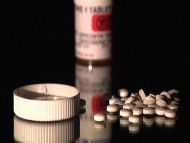
Publisher:
Bonnie King
CONTACT:
Newsroom@Salem-news.com
Advertising:
Adsales@Salem-news.com

~Truth~
~Justice~
~Peace~
TJP
Oct-31-2011 19:15

 TweetFollow @OregonNews
TweetFollow @OregonNews
Is Purdue Pharma-Sponsored 'Partnership at drugfree.org' a Ruse?
Marianne Skolek Salem-News.com"Integrity is the lifeblood of democracy -- Deceit is a poison in its veins." Senator Edward (Ted) Kennedy
Part 1 of 2
 Courtesy: soberliving.com |
(MYRTLE BEACH, S.C.) - The Partnership at Drugfree.org was launched in 1987 and makes some self-serving statements concerning its "public education campaign" -- but is it bogus?

Are bereaved families of dead victims of the epidemic of prescription drugs being lied to? Straight off the Partnership at Drugfree.org website is the below statement with some very impressive statistics that indicate illicit drug use has fallen by 32%.
It appears Partnership at Drugfree.org is taking credit for bringing a level of success to the epidemic of drug use in the U.S. So why is the U.S. and Canada in a Tsunami of drug addiction, death and abuse while the pharmaceutical industry pushes for the "undertreatment of pain" in America -- and the Partnership at Drugfree.org has Purdue Pharma as a sponsor -- the company that has made billions of dollars by criminally marketing OxyContin?
(Marianne Skolek's comments to quotations in articles are in parenthesis).
Partnership at Drugfree.org statement off their website --
Why Partner With Us?
Cited by The New York Times as “one of the most effective drug prevention organizations in the US”, The Partnership at Drugfree.org was selected as one of 13 organizations worldwide to receive the prestigious Discovery Health Channel’s Medical Honors award for its extraordinary contributions to world health. Since 1987, when the organization launched the largest public education campaign in our nation’s history, the use of illicit drugs has fallen by more than 32%, equaling 7.4 million fewer drug users.
The Substance Abuse and Mental Health Services Administration (SAMHSA) disagrees with Partnership at Drugfree.org --
- More young adults aged 18 to 25 are using illicit drugs, up from 19.6% in 2008 to 21.5% in 2010.

Drug overdose death rates in the United States have never been higher.
- Drug overdose death rates have risen steadily in the United States since 1970. (See Figure 1 or read text version).
- In 2007, 27,658 unintentional drug overdose deaths occurred in the United States.
- Drug overdose deaths were second only to motor vehicle crash deaths among leading causes of unintentional injury death in 2007 in the United States.
The increase in drug overdose death rates is largely because of prescription opioid painkillers.
- Among deaths attributed to drugs, the most common drug categories are cocaine, heroin, and a type of prescription drug called opioid painkillers.
- “Opioids” are synthetic versions of opium. They have the ability to reduce pain but can also suppress breathing to a fatal degree when taken in excess. Examples of opioids are oxycodone (OxyContin®), hydrocodone (Vicodin®), and methadone.
- Because opioids cause euphoria, they have been associated increasingly with nonmedical, recreational use. Opioids are now widely available in illicit markets in the United States.

Overall drug overdose death rates in the United States vary by state and region.
- States in the Appalachian region and the Southwest have the highest death rates. (See Figure 3 or read text version).
- The highest drug overdose death rate was found in West Virginia, which was nearly 7 times that of the state with the lowest drug overdose death rate, South Dakota.
- In 2007, states such as California and New York had some of the lowest overall death rates among all states because of low opioid overdose rates. In contrast, in the early 1990s these states had some of the highest overall rates, largely because of high heroin and cocaine overdose rates.

Recommendations by Center for Disease Control
- Use opioid medications for acute or chronic pain only after determining that alternative therapies do not deliver adequate pain relief. The lowest effective dose of opioids should be used.
- In addition to behavioral screening and use of patient contracts, consider random, periodic, targeted urine testing for opioids and other drugs for any patient less than 65 years old with noncancer pain who is being treated with opioids for more than six weeks.
- If a patient’s dosage has increased to 120 morphine milligram equivalents per day or more without substantial improvement in pain and function, seek a consult from a pain specialist.
- Do not prescribe long-acting or controlled-release opioids (e.g., OxyContin®, fentanyl patches, and methadone) for acute pain.
- Periodically request a report from your state prescription drug monitoring program on the prescribing of opioids to your patients by other providers.
- To the extent permitted by applicable law, state prescription drug monitoring programs should routinely send reports to providers on patients less than 65 years old if they are being treated with opioids for more than 6 weeks by two or more providers or if there are signs of inappropriate use of controlled substances. (If legal authority to do so does not exist, work toward obtaining that authority.)
- To the extent permitted by applicable law, state and federal benefits programs should consider monitoring prescription claims information for signs of inappropriate use of controlled substances by patients. For patients whose use of multiple providers cannot be justified on medical grounds, such programs should consider reimbursing opioid prescription claims from a single designated physician and a single designated pharmacy.
- State and federal agencies should work to improve the availability of substance abuse treatment services.
Contact Us:
- Centers for Disease Control and Prevention
National Center for Injury Prevention and Control (NCIPC)
4770 Buford Hwy, NE
MS F
Atlanta, GA 30341-3717
 Salem-News.com Reporter Marianne Skolek, is an Activist for Victims of OxyContin and Purdue Pharma throughout the United States and Canada. In July 2007, she testified against Purdue Pharma in Federal Court in Virginia at the sentencing of their three CEO's - Michael Friedman, Howard Udell and Paul Goldenheim - who pleaded guilty to charges of marketing OxyContin as less likely to be addictive or abused to physicians and patients. She also testified against Purdue Pharma at a Judiciary Hearing of the U.S. Senate in July 2007. Marianne works with government agencies and private attorneys in having a voice for her daughter Jill, who died in 2002 after being prescribed OxyContin, as well as the voice for scores of victims of OxyContin. She has been involved in her work for the past 8-1/2 years and is currently working on a book that exposes Purdue Pharma for their continued criminal marketing of OxyContin.
Salem-News.com Reporter Marianne Skolek, is an Activist for Victims of OxyContin and Purdue Pharma throughout the United States and Canada. In July 2007, she testified against Purdue Pharma in Federal Court in Virginia at the sentencing of their three CEO's - Michael Friedman, Howard Udell and Paul Goldenheim - who pleaded guilty to charges of marketing OxyContin as less likely to be addictive or abused to physicians and patients. She also testified against Purdue Pharma at a Judiciary Hearing of the U.S. Senate in July 2007. Marianne works with government agencies and private attorneys in having a voice for her daughter Jill, who died in 2002 after being prescribed OxyContin, as well as the voice for scores of victims of OxyContin. She has been involved in her work for the past 8-1/2 years and is currently working on a book that exposes Purdue Pharma for their continued criminal marketing of OxyContin.
Marianne is a nurse having graduated in 1991 as president of her graduating class. She also has a Paralegal certification. Marianne served on a Community Service Board for the Courier News, a Gannet newspaper in NJ writing articles predominantly regarding AIDS patients and their emotional issues. She was awarded a Community Service Award in 1993 by the Hunterdon County, NJ HIV/AIDS Task Force in recognition of and appreciation for the donated time, energy and love in facilitating a Support Group for persons with HIV/AIDS.
Marianne Skolek
National Activist for Victims of OxyContin and
Purdue Pharma - a criminally convicted pharmaceutical company
Staff Writer, Salem-News.com
www.purduepharma.com/
judiciary.senate.gov/hearings/testimony.cfm?id=2905&wit_id=6612
i.bnet.com/blogs/
www.vawd.uscourts.gov/
Articles for October 30, 2011 | Articles for October 31, 2011 | Articles for November 1, 2011

googlec507860f6901db00.html
Salem-News.com:



Terms of Service | Privacy Policy
All comments and messages are approved by people and self promotional links or unacceptable comments are denied.
Lord Voldemort November 8, 2011 8:13 am (Pacific time)
I started taking this after my knee surgery, I found it to be be great. My recovery time was fast. I had no pain and lot's of energy. It started with 3 or 4 pills a day then after that it got to be 5 or 6 a day. I then had foot surgery. I had to take more for the pain to go away. This went on for 5 years. By the time I got help I was taking 20 to 25 pills A DAY. I now know that God is watching over me because if he wasn't I wouldn't be here now. Thank God comes to read content from Findrxonline.com/talk which indicate that these medicines have side effects that can be fatal. I am now off of all pain killers but it took a lot of hard work. I'm letting you know this because it creeps up on you before you even know it. Vicodin may help you at first and you may be able to control it. I thought I could. I'm just asking you please be careful with this medicine.
Stwart Jenssen November 2, 2011 9:43 am (Pacific time)
When I was in the hospital over the weekend for surgery, they gave me percocet for the pain and it was amazing! It did not dull the pain, the pain stopped it. Which was such a relief, cause it was super bad for the first couple days after the surgery. Now that I am home I am using vicodin. But it does not help as much. It does dull the pain, but not totally make it go away. I can't even take two vicodin if needed. Why did percocet work so much better? I thought vicodin was the strongest stuff you could use. I reported on the blog of Findrxonline on both medicines and indicate that they are used to counteract the pain, although I still don't understand the difference between the two. Any comments that will help me be more clear about the idea.
parent of addict November 1, 2011 6:31 am (Pacific time)
Another well written article as always! Thank you www.addictionjournal.net
[Return to Top]©2025 Salem-News.com. All opinions expressed in this article are those of the author and do not necessarily reflect those of Salem-News.com.